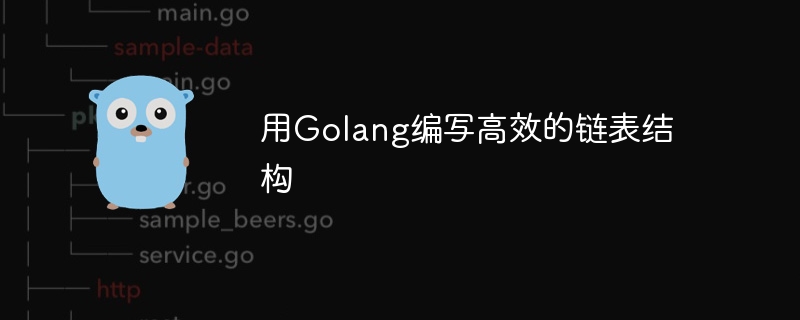创建高性能链表结构,使用Golang编写

Golang是一门高性能的编程语言,它的并发能力和内存管理使得它非常适合编写高效的数据结构。链表是一种常见的数据结构,下面将介绍如何使创建高性能链表结构,使用Golang编写,并提供具体的代码示例。
链表是一种线性数据结构,它由一个个节点组成,每个节点包含一个值和指向下一个节点的指针。相比于数组,链表的优势在于插入和删除元素的效率更高,因为不需要移动其他元素。然而,链表的查找效率相对较低,因为需要从头节点开始逐个访问。
首先,我们定义一个链表节点的结构体,代码如下:
type Node struct {
value int
next *Node
}在链表结构体中,我们定义了一个整数类型的值和一个指向下一个节点的指针。接下来,我们定义链表结构体,包含一个头节点和一个尾节点的指针。
type LinkedList struct {
head *Node
tail *Node
}现在我们可以实现链表的一些基本操作,比如插入、删除和查找。下面是插入操作的代码示例:
func (list *LinkedList) Insert(value int) {
newNode := &Node{value: value}
if list.head == nil {
list.head = newNode
list.tail = newNode
} else {
list.tail.next = newNode
list.tail = newNode
}
}在插入操作中,我们首先判断链表是否为空,如果为空,头节点和尾节点都指向新节点。如果不为空,我们将新节点添加到尾节点后面,并将新节点设置为新的尾节点。
下面是删除操作的代码示例:
func (list *LinkedList) Remove(value int) {
if list.head == nil {
return
}
if list.head.value == value {
list.head = list.head.next
if list.head == nil {
list.tail = nil
}
return
}
prev := list.head
current := list.head.next
for current != nil {
if current.value == value {
prev.next = current.next
if current == list.tail {
list.tail = prev
}
return
}
prev = current
current = current.next
}
}删除操作首先判断链表是否为空,如果为空则直接返回。然后我们通过遍历链表找到要删除的节点,在删除节点之前保存其前驱节点,然后将前驱节点的next指向待删除节点的next。需要特别注意的是,如果待删除节点是尾节点时,需要更新链表的尾节点。
最后,我们来实现链表的查找操作:
func (list *LinkedList) Search(value int) bool {
current := list.head
for current != nil {
if current.value == value {
return true
}
current = current.next
}
return false
}查找操作很简单,我们只需遍历链表并比较节点的值是否等于目标值。
现在我们已经实现了链表的基本操作,可以通过以下代码示例来使用链表:
func main() {
list := LinkedList{}
list.Insert(1)
list.Insert(2)
list.Insert(3)
fmt.Println(list.Search(2)) // Output: true
list.Remove(2)
fmt.Println(list.Search(2)) // Output: false
}以上就是使创建高性能链表结构,使用Golang编写的代码示例。链表是一种重要的数据结构,掌握如何编写高效的链表实现对于解决实际问题非常有帮助。希望本文对你有所帮助!
以上是创建高性能链表结构,使用Golang编写的详细内容。更多信息请关注PHP中文网其他相关文章!

热AI工具

Undresser.AI Undress
人工智能驱动的应用程序,用于创建逼真的裸体照片

AI Clothes Remover
用于从照片中去除衣服的在线人工智能工具。

Undress AI Tool
免费脱衣服图片

Clothoff.io
AI脱衣机

Video Face Swap
使用我们完全免费的人工智能换脸工具轻松在任何视频中换脸!

热门文章

热工具

记事本++7.3.1
好用且免费的代码编辑器

SublimeText3汉化版
中文版,非常好用

禅工作室 13.0.1
功能强大的PHP集成开发环境

Dreamweaver CS6
视觉化网页开发工具

SublimeText3 Mac版
神级代码编辑软件(SublimeText3)
 如何使用 Golang 安全地读取和写入文件?
Jun 06, 2024 pm 05:14 PM
如何使用 Golang 安全地读取和写入文件?
Jun 06, 2024 pm 05:14 PM
在Go中安全地读取和写入文件至关重要。指南包括:检查文件权限使用defer关闭文件验证文件路径使用上下文超时遵循这些准则可确保数据的安全性和应用程序的健壮性。
 如何为 Golang 数据库连接配置连接池?
Jun 06, 2024 am 11:21 AM
如何为 Golang 数据库连接配置连接池?
Jun 06, 2024 am 11:21 AM
如何为Go数据库连接配置连接池?使用database/sql包中的DB类型创建数据库连接;设置MaxOpenConns以控制最大并发连接数;设置MaxIdleConns以设定最大空闲连接数;设置ConnMaxLifetime以控制连接的最大生命周期。
 如何在 Golang 中将 JSON 数据保存到数据库中?
Jun 06, 2024 am 11:24 AM
如何在 Golang 中将 JSON 数据保存到数据库中?
Jun 06, 2024 am 11:24 AM
可以通过使用gjson库或json.Unmarshal函数将JSON数据保存到MySQL数据库中。gjson库提供了方便的方法来解析JSON字段,而json.Unmarshal函数需要一个目标类型指针来解组JSON数据。这两种方法都需要准备SQL语句和执行插入操作来将数据持久化到数据库中。
 Golang框架与Go框架:内部架构与外部特性对比
Jun 06, 2024 pm 12:37 PM
Golang框架与Go框架:内部架构与外部特性对比
Jun 06, 2024 pm 12:37 PM
GoLang框架与Go框架的区别体现在内部架构和外部特性上。GoLang框架基于Go标准库,扩展其功能,而Go框架由独立库组成,实现特定目的。GoLang框架更灵活,Go框架更容易上手。GoLang框架在性能上稍有优势,Go框架的可扩展性更高。案例:gin-gonic(Go框架)用于构建RESTAPI,而Echo(GoLang框架)用于构建Web应用程序。
 如何找出 Golang 正则表达式匹配的第一个子字符串?
Jun 06, 2024 am 10:51 AM
如何找出 Golang 正则表达式匹配的第一个子字符串?
Jun 06, 2024 am 10:51 AM
FindStringSubmatch函数可找出正则表达式匹配的第一个子字符串:该函数返回包含匹配子字符串的切片,第一个元素为整个匹配字符串,后续元素为各个子字符串。代码示例:regexp.FindStringSubmatch(text,pattern)返回匹配子字符串的切片。实战案例:可用于匹配电子邮件地址中的域名,例如:email:="user@example.com",pattern:=@([^\s]+)$获取域名match[1]。
 从前端转型后端开发,学习Java还是Golang更有前景?
Apr 02, 2025 am 09:12 AM
从前端转型后端开发,学习Java还是Golang更有前景?
Apr 02, 2025 am 09:12 AM
后端学习路径:从前端转型到后端的探索之旅作为一名从前端开发转型的后端初学者,你已经有了nodejs的基础,...
 如何用 Golang 使用预定义时区?
Jun 06, 2024 pm 01:02 PM
如何用 Golang 使用预定义时区?
Jun 06, 2024 pm 01:02 PM
Go语言中使用预定义时区包括以下步骤:导入"time"包。通过LoadLocation函数加载特定时区。在创建Time对象、解析时间字符串等操作中使用已加载的时区,进行日期和时间转换。使用不同时区的日期进行比较,以说明预定义时区功能的应用。
 golang框架开发实战教程:常见疑问解答
Jun 06, 2024 am 11:02 AM
golang框架开发实战教程:常见疑问解答
Jun 06, 2024 am 11:02 AM
Go框架开发常见问题解答:框架选择:取决于应用需求和开发者偏好,如Gin(API)、Echo(可扩展)、Beego(ORM)、Iris(性能)。安装和使用:使用gomod命令安装,导入框架并使用。数据库交互:使用ORM库,如gorm,建立数据库连接和操作。身份验证和授权:使用会话管理和身份验证中间件,如gin-contrib/sessions。实战案例:使用Gin框架构建一个简单的博客API,提供POST、GET等功能。






